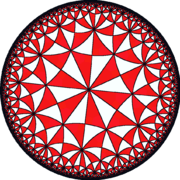Gromov boundary


In mathematics, the Gromov boundary of a δ-hyperbolic space (especially a hyperbolic group) is an abstract concept generalizing the boundary sphere of hyperbolic space. Conceptually, the Gromov boundary is the set of all points at infinity. For instance, the Gromov boundary of the real line is two points, corresponding to positive and negative infinity.
Definition
There are several equivalent definitions of the Gromov boundary of a geodesic and proper δ-hyperbolic space. One of the most common uses equivalence classes of geodesic rays. [1]
Pick some point of a hyperbolic metric space to be the origin. A geodesic ray is a path given by an isometry such that each segment is a path of shortest length from to .
We say that two geodesics are equivalent if there is a constant such that for all . The equivalence class of is denoted .
The Gromov boundary of a geodesic and proper hyperbolic metric space is the set is a geodesic ray in .
Topology
It is useful to use the Gromov product of three points. The Gromov product of three points in a metric space is . In a tree (graph theory), this measures how long the paths from to and stay together before diverging. Since hyperbolic spaces are tree-like, the Gromov product measures how long geodesics from to and stay close before diverging.
Given a point in the Gromov boundary, we define the sets there are geodesic rays with and . These open sets form a basis for the topology of the Gromov boundary.
These open sets are just the set of geodesic rays which follow one fixed geodesic ray up to a distance before diverging.
This topology makes the Gromov boundary into a compact metrizable space.
The number of ends of a hyperbolic group is the number of components of the Gromov boundary.
Properties of the Gromov boundary
The Gromov boundary has several important properties. One of the most frequently used properties in group theory is the following: if a group acts geometrically on a δ-hyperbolic space, then is hyperbolic group and and have homeomorphic Gromov boundaries.[2]
One of the most important properties is that it is a quasi-isometry invariant; that is, if two hyperbolic metric spaces are quasi-isometric, then the quasi-isometry between them gives a homeomorphism between their boundaries.[3][4] This is important because homeomorphisms of compact spaces are much easier to understand than quasi-isometries of spaces.
Examples
- The Gromov boundary of a tree is a Cantor set.
- The Gromov boundary of hyperbolic n-space is an (n-1)-dimensional sphere.
- The Gromov boundary of most hyperbolic groups is a Menger sponge [5]
Cannon's Conjecture
Cannon's conjecture concerns the classification of groups with a 2-sphere at infinity:
Cannon's conjecture: Every Gromov hyperbolic group with a 2-sphere at infinity acts geometrically on hyperbolic 3-space.[6]
The analog to this conjecture is known to be true for 1-spheres and false for spheres of all dimension greater than 2.
References
- ↑ Kapovich, Ilya, and Nadia Benakli. "Boundaries of hyperbolic groups." Combinatorial and geometric group theory (New York, 2000/Hoboken, NJ, 2001) 296 (2002): 39-93.
- ↑ Gromov, M. Hyperbolic groups. Essays in group theory, 75–263, Math. Sci. Res. Inst. Publ., 8, Springer, New York, 1987
- ↑ Michel Coornaert, Thomas Delzant and Athanase Papadopoulos, "Géométrie et théorie des groupes : les groupes hyperboliques de Gromov", Lecture Notes in Mathematics, vol. 1441, Springer-Verlag, Berlin, 1990, x+165 pp. MR 92f:57003, ISBN 3-540-52977-2
- ↑
- É. Ghys and P. de la Harpe (editors), Sur les groupes hyperboliques d'après Mikhael Gromov. Progress in Mathematics, 83. Birkhäuser Boston, Inc., Boston, MA, 1990. xii+285 pp. ISBN 0-8176-3508-4
- ↑ C. Champetier, Proprietes statistiques des groupes de presentation finie, Adv. Math. 116 (1995), no. 2, 197--262. MR 96m:2005
- ↑ James W. Cannon. The combinatorial Riemann mapping theorem. Acta Mathematica 173 (1994), no. 2, pp. 155–234.